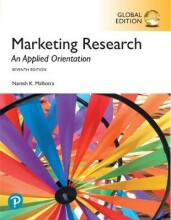Causal Research Design: Experimentation
34 important questions on Causal Research Design: Experimentation
How do you call the situation when the occurence of X increases the probability of the occurence of Y?
How do you call a condition for inferring causality that requires that a cause, X and an effect, Y, occur together or vary together as predicted by the hypothesis under consideration?
How do you call variables that are manipulated by the researcher and whose effects are measured and compared?
- Higher grades + faster learning
- Never study anything twice
- 100% sure, 100% understanding
How do you call individuals, organizations, or other entities whose response to independent variables or treatment is being studied?
How do you call the set of experimental procedures specifying (1) the test units and sampling procedures, (2) independent variables, (3) dependent variables, (4) how to control the extraneous variables?
How do you call a measure of accuracy of an experiment that determines whether the manipulation of the independent variables, or treatments, actually caused the effects on the dependent variable(s)?
How do you call a determination of whether the cause-and-effect relationships found in the experiment can be generalized?
How do you call an extraneous variable attributable to change in the test units themselves that occur with the passage of time?
How do you call an effect of testing occurring when a prior observation affects a latter observation?
How do you call an effect in which a prior measurement affects the test unit's response to the independent variable?
How do you call an extraneous variable involving changes in the measuring instrument or in the observers or scores themselves?
How do you call an extraneous variable that occurs when test units with extreme scores move closer to the average score during the course of the experiment?
How do you call an extraneous variable attributable to the improper assignment of test units to treatment conditions?
How do you call an extraneous variable attributable to the loss of test units while the experiment is in progress?
How do you call synonymous with extraneous variables, used to illustrate that extraneous variables can confound the results influencing the dependent variable?
How do you call one method of controlling extraneous variables that involves matching test units on a set of key background variables before assigning them to the treatment conditions?
How do you call one method of controlling extraneous variables by measuring the extraneous variables and adjusting for their effects through statistical methods?
How do you call experimental designs distinguished by the fact that the researcher can randomly assign test units to experimental groups and also randomly assign treatments to experimental groups?
How do you call designs that apply part of the procedures of true experimentation but lack full experimental control?
How do you call a pre-experimental design in which a single group of test units is exposed to a treatment X, and then a single measurement on the dependent variable is taken?
How do you call a pre-experimental design in which a group of test units is measured twice?
How do you call a pre-experimental design in which there are two groups: the experimental group (EG), which is exposed to the treatment, and the control group (CG)?
How do you call a true experimental design that explicitly controls for interactive testing effects, in addition to controlling for all the other extraneous variables?
How do you call a quasi-experimental design that involves periodic measurements on the dependent variable for a group of test units?
How do you call a statistical design in which the test units are blocked based on an external variable to ensure that the various experimental and control groups are matched closely on that variable?
How do you call a statistical design that allows for the statistical control of two noninteracting external variables in addition to the manipulation of the independent variable?
How do you call a statistical experimental design that is used to measure the effects of two or more independent variables at various levels and to allow for interactions between variables?
How do you call an artificial setting for experimentation in which the researcher constructs the desired conditions?
How do you call an experimental location set in actual market conditions?
How do you call a phenomenon in which respondents attempt to guess the purpose of the experiment and respond accordingly?
How do you call an application of a controlled experiment done in limited, but carefully selected, test markets?
How do you call carefully selected parts of the marketplace that are particularly suitable for test marketing?
How do you call after the experiment, informing test subjects what the experiment was about and how the experimental manipulations were performed?
What are the seven extraneous factors that threaten the internal and external validity of the experiment may be described by the acronym threats?
- Testing
- History
- Regression
- Errors in measurement: instrumentation
- Ageing: maturation
- Termination of test units: mortality
- Selection bias
The question on the page originate from the summary of the following study material:
- A unique study and practice tool
- Never study anything twice again
- Get the grades you hope for
- 100% sure, 100% understanding































